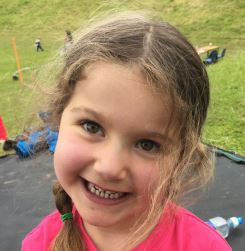Wednesday 24 February 2016
Little S had surprisingly high sats this week – 78% when the community nurse came over on Monday and 84% when Little S went to Barnet Hospital today.
Although she is no stranger to hospitals, she wasn’t supposed to be in hospital today – this wasn’t a planned visit – she was only there because she fell off a space hopper at school, bashed her head and had a big lump appearing by the time J arrived to pick her up!
However, once they reached the hospital, with big sis T in tow, Little S was feeling much better and quite enjoying the attention! And with sats of 84%, J wasn’t too concerned either. But the hospital staff were worried as Little S is a bit complicated and red-flagged on her notes as a child to be particularly careful about.
So, after an hour of waiting for a consultant and with Little S clearly fine, J took the executive decision to discharge her herself and headed back home.
Even her sats earlier in the week had no right to be as high as they were (note the relative use of the word ‘high’ and remember that most of us would be dead with sats of 78%) given that she was off school that day as she’d been sick and under the weather that morning.
Seeing sats in the high 70’s (and over 80 at hospital) was particularly encouraging, with the reading in Barnet Hospital corroborating the community nurse’s figure earlier in the week, as her sats had been stubbornly low (around 72%) for about three months now, and it had looked like the procedure that she had done in October was not having the effect that we’d hoped for.
Back in October her sats had increased to around 80% but only for the week or so following the catheterisation performed by Dr D that dilated her pseudo pulmonary arteries in four places in order to improve the flow of deoxygenated blood from her heart to her lungs and thus increase her overall oxygen levels –
I say ‘pseudo’ pulmonary arteries because, as you may well remember, they were constructed during major surgery by combining the extra arteries that Little S had created in utero from her left subclavian artery (from her shoulder) and her right coronary artery (from her heart) before the amazing GOSH surgeons attached them to a small GoreTex tube that took the place of her missing pulmonary valve.
The cath procedure was a lot less risky than major heart surgery but still involved general anaesthetic and had the potential to cause a number of nasty complications if things didn’t go to plan.
The good news was that it was a lot smoother from our point of view than the previous one in Nov ’14 –
waiting on the day ward with familiar, friendly nurses that have got to know Little S over the years;
better, calmer ‘bedside manner’ during the pre-brief which put us more at ease;
a better anaesthetist, able to slowly, slowly send Little S to sleep without any plaintive cries for help;
and, most importantly, a phone call of reassurance when the procedure was over letting us know that everything was fine and not (you’ll remember from the year before) creating panic, fear and uncertainty for the longest ten minutes until we saw our gorgeous bundle waking up with her teddy beside her and wishing mummy was there.
Like the previous year it only took an overnight stay for Little S to be ready to head for home – indeed, by the time I’d arrived back at GOSH the following morning, Little S was out of bed, and her and J were playing on the floor, packed and waiting to ‘check-out’: my Dad had come up to London to spend some time with them, bless him, and I suspect hadn’t banked on them leaving the hospital so shortly after he’s arrived! But it takes more than a general anaesthetic and 3 hours of someone fiddling with your arteries to stop Little S getting back home!
Since the cath, Dr D has been talking about a plan for the next stage which would involve more major surgery to replace the GoreTex tube with a proper valve that could be resized as required to grow with her over the next few years and potentially into adulthood.
To have a plan like this now is amazing.
Since December 2013 we’ve not been able to think for anything more than a few months ahead as Dr D had not been convinced of Little S’s resilience to invasive surgery. But with the success of the last two caths, he and the other surgeons at GOSH are prepared to take the next necessary step, although not until Little S’s sats show a further drop below 70%, which would indicate that she’d outgrown the GoreTex tube and needed something bigger to provide her body with sufficient oxygen.
We’ve also been asking Dr B’s opinion in Israel. He also thinks we should get on with the valve replacement, and sooner rather than later. But he has a disagreement with Dr D.
Dr D thinks that if and when we do the surgery we should not also close the VSD (the hole in her heart) whereas Dr B thinks we should. I’d like to understand more about why they think different things before we get to the actual surgery – hopefully the two docs will discuss and come to a consensus on what the right way forward is: if they don’t then I’m not quite sure where that leaves us.
But the great thing is that there is a way forward for Little S, one fraught with great risk, but a way forward nonetheless – hope, again.
